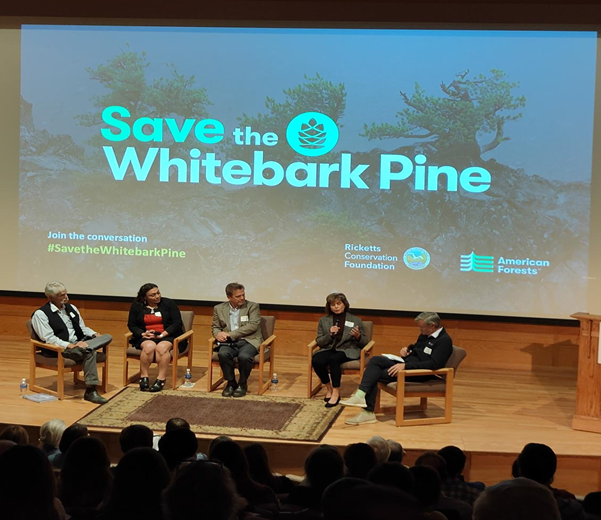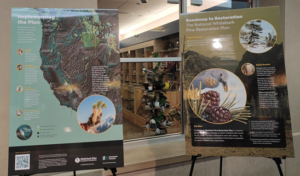
The Bird & the Tree: An Evening for Whitebark Pine
On September 28th, 2023, leaders from land management agencies, non-profits, tribal nations, and the public gathered in Bozeman, MT to discuss the conservation of the threatened whitebark pine. This event premiered the short film “The Bird and the Tree” by the Cornell Lab of Ornithology, highlighting the mutualistic relationship between the Clark’s nutcracker and whitebark pine and the critical role this tree species plays in supporting wildlife. Following the screening, a panel discussion featured Dr. Doug Smith from Yellowstone National Park, ShiNaasha Pete from the Confederated Salish & Kootenai Tribes, Dr. Walter Wehjte from the Ricketts Conservation Foundation, and Dr. Diana Tomback from the Whitebark Pine Ecosystem Foundation who shared their perspectives on the restoration of whitebark pine. Co-hosted by American Forests and the Ricketts Conservation Foundation, this event served as a call for unified action in preserving this keystone species.
Innovative Strategies for Whitebark Pine Preservation
The decline of whitebark pine is alarming considering that as of 2019, 54% of all standing whitebark pine are dead in the western US due to numerous threats. During this event, panelists discussed several ongoing restoration strategies. One approach involves planting whitebark pine with natural resistance to white pine blister rust, an invasive fungal disease that primarily contributes to whitebark pine mortality. However, this process can be costly as it involves certified climbers scaling trees to cage cones, harvesting mature cones, nurturing seedlings in a greenhouse for two years, conducting rust-resistance screenings on the seedlings for three years to confirm their rust resistance, and monitoring the seedlings for up to an additional 5-10 years, totaling around $1200 – $1800 per tree. In addition to growing rust-resistant seedlings, another cost-effective method is direct seeding of seeds from rust-resistant trees into the ground, eliminating greenhouse-related expenses. Other restorative measures discussed by the panel include protecting whitebark pine from mountain pine beetle outbreaks by attaching pheromone packets to tree trunks, effectively signaling a “no vacancy” message to these pests. To address the added threat of wildfires, implementing fire mitigation strategies like thinning prescriptions to reduce fuel loads is another strategy to enhance whitebark pine conservation efforts.
In parallel with these restoration approaches, a particularly promising innovation in the works that the panelists highlighted is the whitebark pine genome project, which is coordinated by Whitebark Pine Ecosystem Foundation board chair Dr. David Neale. This initiative aims to sequence the genome of whitebark pine and identify the genes responsible for resistance to white pine blister rust, as well as potential resistance to other threats such as drought and the mountain pine beetle. In doing so, identifying rust-resistant trees for seed collection will be expedited as only small amounts of needle tissue will need to be collected and screened for rust-resistant genes. Seeds from these rust-resistant trees can then be immediately used for future planting, eliminating the need for rust-resistant screenings in a greenhouse as previously described. Therefore, the genome project could significantly reduce costs to as little as $100 per tree and time to a matter of weeks, offering a more efficient approach towards whitebark pine restoration.
Implementing the Whitebark Pine Restoration Plan
With a draft completed earlier this year, the National Whitebark Pine Restoration Plan is scheduled for release later this winter. Panelists elaborated on this comprehensive plan that spans across seven states and involves multiple forest management jurisdictions, including the National Park Service, U.S. Forest Service, Bureau of Land Management, and tribal nations. The Restoration Plan uses a spatially explicit strategy, with each jurisdiction designating 20-30% of its whitebark pine population for priority restoration activities, which could include genetic testing, fuel reductions, beetle management, seed collection, planting disease-resistant and drought-tolerant seedlings, and monitoring seedling health. Given the 10-20 mile foraging radius of Clark’s nutcrackers, the hope is that these birds will then effectively disperse the seeds from mature rust-resistant and drought-tolerant trees throughout the surrounding ecosystem.
Fostering Hope for the Future of Whitebark Pine
Despite the many challenges whitebark pine faces, panelists expressed hope for its recovery due to its resilience, combined with a range of restoration tools and joint initiatives. Given that 90% of whitebark pine grows on public lands, there is promising potential for collaborative solutions. A notable example is the Greater Yellowstone Coordinating Committee (GYCC), a diverse coalition of federal, state, tribal, nonprofit, and other stakeholders that helps coordinate whitebark pine restoration efforts including research, monitoring, seed collection and distribution, and public outreach. This collaborative approach not only contributes to whitebark pine conservation efforts, but it also offers hope for establishing a framework for the restoration of other declining tree species, such as the limber pine. Most significantly, multiple panelists had faith that the interdependent relationship between the Clark’s nutcracker and whitebark pine will be a driving force behind the tree species’ recovery. Through dedicated restoration actions, the hope is that these vital birds will facilitate seed dispersal and range expansion.

Graphics outlining the restoration plan and its implementation strategy. Credit: American Forests

